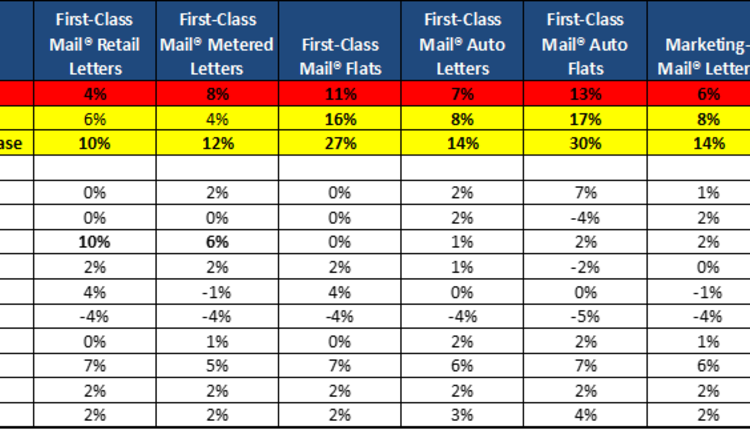Postal rates are supposed to be tied to the Consumer Price Index (CPI), which today is running at one to two percent. Although the overall increase may be in this range, we found that certain rates went down, while others went up dramatically. Also, this rule does not impact what the USPS considers “competitive” shipping services, where it has more flexibility to increase rates.
For the past 18 years, I have been creating comparison charts that go over the changes in rates to show how it will affect budgets. The reason that I do this is because when the USPS talks about a one to two percent increase, it’s important to remember this is overall. Based on the type of mail you do, the increase could be higher or lower. You need to look at the class, weight, zone, density, and special services required to see the true impact. Also, when you look at the new rate charts provided by the USPS, they typically will not show the level of detail needed (the previous and new rates side by side, for example) to see these differences.
The remainder of this article will look at the main classes of mail to break down the specific increases and decreases. Hopefully this will help you budget by seeing the impact of the most common services that you use today.
First-Class Mail Single piece - 1.1% Decrease to 9% Increase
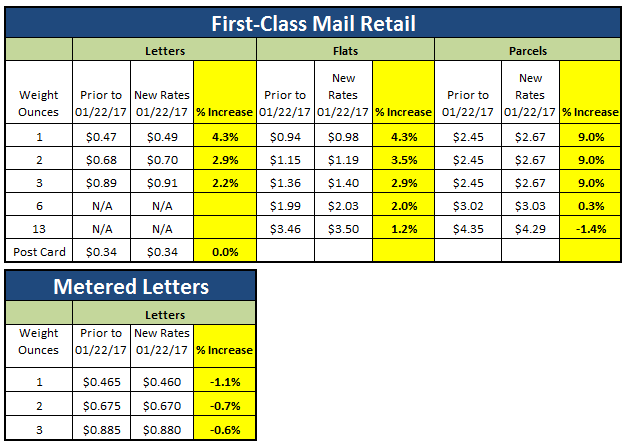
The price of a stamp is going from $0.47 to $0.49, which is a 4.3% increase. The USPS did not increase the additional ounce rate so the percentage change gets smaller as items get larger. This is compared to metered letters, which will have a price reduction from $0.465 down to $0.46. This is the most significant savings ever offered in the US mailing industry because it means that by using a postage meter or PC postage, you will save $0.03 per piece, or 6.1%. Most discounts are tied to doing more work such as barcoding or sorting, whereas this is an automatic savings for just using a system that costs as little as $20 per month to print postage.
Other interesting items in this category are the rates for flats, which went up to $0.98. It is believed this happened so retail customers could use two stamps to pay the full amount of postage. Also, lightweight parcels went up by nine percent because of the growth in shipping and lack of competition for light weight packages.
First-Class Mail Commercial - 0.8% Decrease to 9% Increase

Rates stayed relatively flat in this category with slight changes based on sort levels. Mailers will see extra discounts at the five-digit category, and it may mean it is time to renegotiate rates with your presort service as they are getting a larger share of the savings. Full Service IMb customers will still be entitled to the additional $.003 savings. The USPS eliminated the three-digit sort level for letters and post cards, which makes sense because the rates were the same as the AADC category and it will be simpler for mailers to prepare trays.
The biggest change in this category is increasing the weight limit for the letter rates from two to 3.5 ounces. A few years back, the USPS initiated a plan where the second ounce rides free. The goal was to increase the value of the mail piece, allowing customers to add additional content at the same price. The USPS has now increased this limit from two to 3.5 ounces, which means that there is an incredible amount of material that can now be put into the envelope at no additional postage cost.

When you look at the chart above and compare the rates of a three-ounce metered letter at $0.88 to a commercial rate at $0.373, it is a 58% savings! This is going to be a big win for presort services that will now become more valuable because of the savings they can provide. Also for flats (9x12 or 10x13), consider folding those into 6x9 envelopes. The savings can be significant with these new rates and weight savings. A three-ounce flat at $1.40 now could cost only $0.373, assuming it could be automated through in-house software or presort services.
Marketing Mail (Formerly called Standard Mail) – 4.3% Decrease to 3% Increase
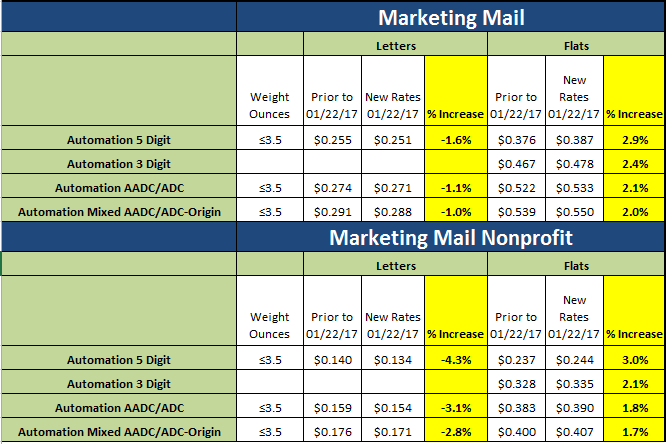
Customers who are sending Marketing Mail Letters will be happy to see a decrease in price while Flats are seeing small increases. Here are the other notable changes:
· The USPS has eliminated the three-digit sort level for letters, which will hopefully make preparation easier.
· Letter weight limit has increased from 3.3 to 3.5 ounces before per pound rates are required.
· Flats have also increased the weight break from 3.3 to four ounces prior to pound rates being calculated.
Priority Mail – 19% Decrease to 62% Increase (Depending on Weight and Zone)

Priority Mail is the most popular package service for the USPS, covers items weighing 13 ounces to 70 pounds, and delivers in one to three days throughout the US. The rates are based on the weight and nine zones, which are determined by the distance you are shipping the item. They also have three different rate categories based on the type of customer.
· Retail – Rates that you get at the counter at the post office or through a postage meter.
· Commercial Base – Customers that use an approved PC Postage solution get significant discounts over retail rates as an incentive to streamline the way packages are labeled and barcoded and how data is transmitted.
· Commercial Plus – Customers that ship over 50,000 items per year can get additional discounts with an agreement with the USPS.
Highlights
· Flat-rate envelopes and boxes are all seeing significant increases.
· Small to no increases to most weights and zones except for 15-32 pound items going in zone 1-4, which are increasing by as much as 62%.
· If you are running your Priority Mail items at retail rates using Click-N-Ship or a postage meter, consider switching to a PC Postage solution that utilizes commercial rates. This saves 15% overall and ranges from three to 39% based on weight and zone.
· If you do over 50,000 Priority Mail items per year combined throughout your locations, contact the USPS about qualifying for plus rates, saving an additional three percent.
Priority Mail Express– 1 to 7% Increase (Depending on Weight and Zone)

Priority Mail Express rates have increased slightly across all categories. Here are the highlights:
· Retail rates increased three percent overall but five percent for flat-rate and less than 10-pound items.
· Commercial rates increased one percent overall but three percent for flat-rate and less than 10-pound items.
· Plus discounts have been eliminated and rates are the same as commercial base.
First-Class Mail Package Service - 0.4 to 17.8% Increase
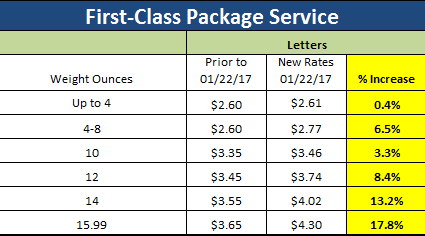
In the less than one pound market, the USPS has a complete monopoly, and you can see that it is rethinking why it is providing some of the discounts in this segment. The private carrier rates all start at one pound, whereas the USPS goes to the ounce. Think about the companies sending light parts that can be sent for around three dollars with the USPS vs. the private carriers that could be two to three times that amount. We are seeing the greatest increase as items get heavier with 15.99 ounce prices going up 17.8%.
Additional Rate Change Items

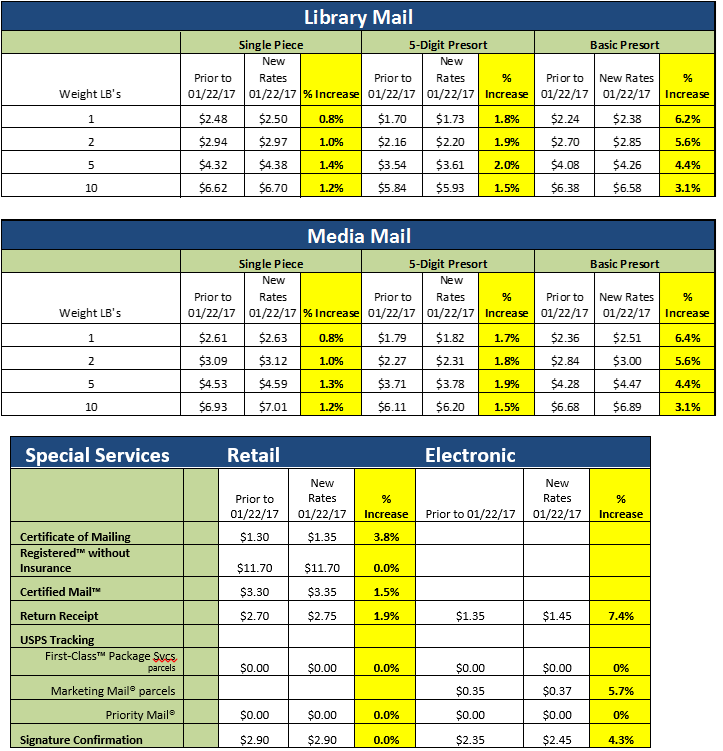
Conclusion
To budget for this increase, you need to look at the type of items you are sending and the weight and zones that are most common to truly estimate the impact. The good news is that for most mailers, this will be a very small impact to your budget with opportunities for savings if you can take advantage of some of the new discounts offered.
Adam Lewenberg, CMDSS, MDC, President of Postal Advocate Inc., runs the largest Mail Audit and Recovery firm in the United States and Canada. They manage the largest mail equipment fleet in the world and their mission is to help organizations with multi-locations reduce mail related expenses, recover lost postage funds, and simplify visibility and oversight. Since 2013, they have helped their clients save an average of 60% and over $26 million on equipment, fee and lost postage. He can be reached at 617.372.6853 or adam.lewenberg@postaladvocate.com.







![GettyImages-1170541989-[Converted]](https://cms-static.wehaacdn.com/mailingsystemstechnology-com/images/GettyImages-1170541989--Converted-.1803.widea.0.jpg)

